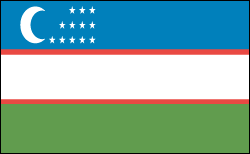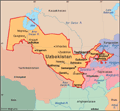Uzbekistan | Facts & Information

- Uzbekistan Profile
- History
- News and Current Events
Facts & Figures
-
President: Islam A. Karimov (1990)
Prime Minister: Shavkat Mirziyayev (2003)
Land area: 164,247 sq mi (425,400 sq km); total area: 172,741 sq mi (447,400 sq km)
Population (2014 est.): 28,929,716 (growth rate: 0.93%); birth rate: 17.02/1000; infant mortality rate: 19.84/1000; life expectancy: 73.29; density per sq mi: 159.1
Capital and largest city (2011 est.): Tashkent, 2.227 million
Other large cities: Namangan, 1.565 million; Andijan, 1.448 million; Samarkand, 1.309 million
Monetary unit: Uzbekistani sum
National name: Ozbekiston Respublikasi
Languages: Uzbek 74.3%, Russian 14.2%, Tajik 4.4%, other 7.1%
Ethnicity/race: Uzbek 80%, Russian 5.5%, Tajik 5%, Kazak 3%, Karakalpak 2.5%, Tatar 1.5%, other 2.5% (1996 est.)
Religions: Islam (mostly Sunnis) 88%, Eastern Orthodox 9%, other 3%
Literacy rate: 99.4% (2011 est.)
Economic summary: GDP/PPP (2013 est.): $112.6 billion; per capita $3,800. Real growth rate: 7%. Inflation: 10.1% officially; 22% based on analysis of consumer prices. Unemployment: 4.9% officially, plus another 20% underemployed. Arable land: 9.61%. Agriculture: cotton, vegetables, fruits, grain; livestock. Labor force: 16.99 million (2013); agriculture 25.9%, industry 13.2%, services 60.9% (2012). Industries: textiles, food processing, machine building, metallurgy, mining, hydrocarbon extraction, chemicals. Natural resources: natural gas, petroleum, coal, gold, uranium, silver, copper, lead and zinc, tungsten, molybdenum. Exports: $14.91 billion (2013 est.): energy products, cotton, gold, mineral fertilizers, ferrous and nonferrous metals, textiles, food products, machinery, automobiles. Imports: $12.64 billion (2013 est.): machinery and equipment, foodstuffs, chemicals, ferrous and nonferrous metals. Major trading partners: Russia, China, Turkey, Kazakhstan, Kyrgyzstan, Bangladesh, South Korea, Germany, Ukraine (2012).
Communications: Telephones: main lines in use: 1.963 million (2012); mobile cellular: 20.274 million (2012). Radio broadcast stations: AM 15, FM 7, shortwave 10 (1998). Radios: 10.2 million (1997). Television broadcast stations: 10 (2013). Televisions: 6.4 million (1997). Internet Service Providers (ISPs): 56,075 (2012). Internet users: 4.689 million (2009).
Transportation: Railways: total: 4,230 km (2012) Highways: total: 86,496 km; paved: 75,511 km; unpaved: 10,985 km (2000). Waterways: 1,100 (2012). Ports and harbors: Termiz (Amu Darya river). Airports: 53 (2013).
International disputes: prolonged drought and cotton monoculture in Uzbekistan and Turkmenistan created water-sharing difficulties for Amu Darya river states; field demarcation of the boundaries with Kazakhstan commenced in 2004; border delimitation of 130 km of border with Kyrgyzstan is hampered by serious disputes around enclaves and other areas.









